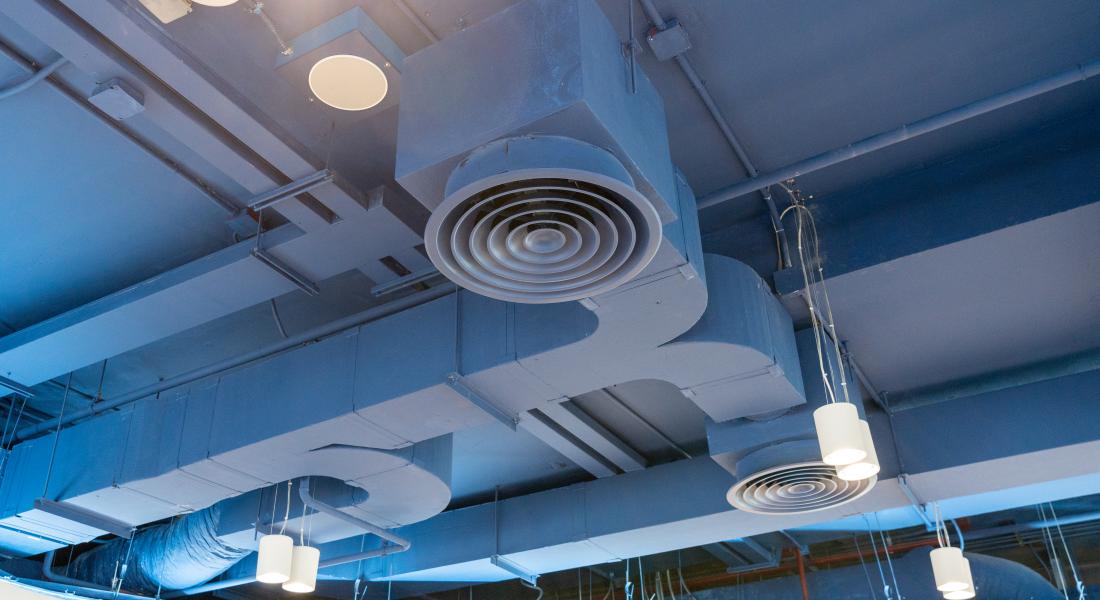Saving energy in HVAC systems: focus on air

Most ventilation and air conditioning systems consume too much energy. An analysis with the econ4 energy management software creates transparency about energy consumption and reveals potential savings. For HVAC systems, it is particularly worthwhile to record the medium air in terms of performance and consumption in econ4. Together with the technologies from Luftmeister GmbH, this is possible.
Well-being and performance at the workplace are strongly influenced by the indoor climate. Who wants to work in a stuffy office that makes you sweat in the summer? Ventilation and air conditioning systems, or HVAC systems for short, are therefore now standard in commercial and industrial properties, where they create a healthy and pleasant indoor climate. They are also important in companies where certain working methods or production processes require a specific indoor climate.
HVAC systems are often energy guzzlers
Even if you wouldn't want to do without them, there is one catch: most ventilation systems consume too much energy. According to Fachverband Gebäude-Klima e. V., the building sector accounts for over 40 percent of final energy consumption in Germany - more than a third of which is used in non-residential buildings. A large proportion of this energy is used for HVAC systems.
Energy management software provides important insights
Is your own HVAC system an expensive energy guzzler? And if so, where can the leverage for greater energy efficiency and sustainable optimization of energy use be applied? One way to find out is to use energy management software, which provides an overview of consumption with just a few clicks and provides users with important insights. They can then make decisions quickly and adapt processes.
econ4: simple energy and consumption recording
One of the leading solutions on the market is the energy management software econ4 from MVV's solution house partner econ solutions GmbH. The software is open for all types of energy, media (electricity, gas, water, etc.) and status data (temperature, pressure, etc.) and automatically evaluates all energy and process data. Thanks to its modular, flexible structure, econ4 can be easily adapted to the individual conditions on site. A major advantage is the manufacturer-independent integration of all data sources, which enables the integration of common measuring devices.
Air flow measurement provides information about efficiency
Many users already include their air handling systems in their energy management. However, this usually only takes into account the energy that the systems require to heat or cool the air. However, the efficiency of the systems can only be determined if measurements are also taken within the air flow. Only then is it possible to say how high the losses are during air treatment.
Integrating air conditioning and process air into econ4
econ solutions now enables its customers to integrate air conditioning and process air into econ4. To this end, the energy management specialist is working together with Luftmeister GmbH, which has developed the world's first air energy meter. Luftmeister measures the air consumption and the useful energy of the zone in the process air systems. The recorded data can be easily and flexibly transferred to econ4 and integrated into the evaluations available here.
Cooperation with specialists for air flow measurement
Luftmeister GmbH is a specialist in the precise measurement of air flow (volume flow, mass flow) in HVAC systems. The company brings together three topics that are often only answered separately, namely air conditioning and process engineering expertise, a focus on energy efficiency and metrological know-how. Against this background, Luftmeister has developed some groundbreaking innovations, including the air energy meter, and successfully implemented several hundred customer projects.
Two practical examples show how econ solutions, together with its partner Luftmeister, enables its customers to record the performance and consumption of air in econ4 and draw the right conclusions.
Example 1: Energy controlling of HVAC systems
Central air handling units should provide all relevant air conditions in a complex, controlled interaction of treatment technology (cooling, heating, heat recovery, etc.) and do so as energy-efficiently as possible. But how can it be ensured, even under partial load, that heat recovery, cooling and heating do not work against each other? And how much useful energy does each treatment stage contribute?
Answers to these questions are provided by the Luftmeister air energy meter, which records the thermal output and the useful thermal energy contribution for each treatment stage by measuring the mass flow. Once analyzed in econ4, the measurement data obtained provides comprehensive information for monitoring the air handling unit, for example to quickly identify faults. At the same time, all relevant data is made available for each operating phase to enable even more efficient control.
Example 2: Outdoor air optimization for recirculation systems
In HVAC systems with recirculation mode, a minimum proportion of outside air - of 20 percent, for example - must be provided to ensure air quality and oxygen supply. At the same time, the outside air should not exceed this minimum proportion, or only minimally, as its treatment (heating in winter, cooling in summer) causes high energy costs. This is usually regulated via the damper position of the recirculation mixing chamber.
With the air master, the volume flow is measured precisely and continuously in the supply air and fresh air ducts, even with short inlet distances. Direct measurement of the fresh air volume flow means that a significantly lower fresh air volume flow can be used permanently. This saves a lot of money on air heating and cooling.
The econ system can be used to receive and analyze the continuous Luftmeister measured values, in this case the outdoor air and supply air volume flows for recirculation systems. On this basis, it is possible
- the proportion of outside air actually supplied by the system can be verified for each point in time (occupational safety issue).
- The actual proportion of outside air can be compared with the target value and adjusted through optimization (e.g. changing the damper settings) - this saves a lot of energy.
Get expert advice now
Would you now like to know whether your ventilation and air conditioning system is working energy-efficiently and where you may need to make adjustments? Please get in touch with us. We will be happy to advise you! An energy analysis of the ventilation and air conditioning system with econ4 by our partner Luftmeister reveals the weak points. This benefits you as well as the environment.

